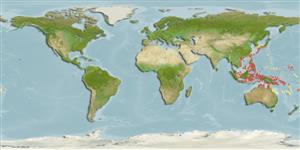>
Gobiiformes (Gobies) >
Gobiidae (Gobies) > Gobiinae
Etymology: Cryptocentrus: Greek, kryptos = hidden + Greek, kentron = sting (Ref. 45335).
Environment: milieu / climate zone / depth range / distribution range
Ekologi
laut berasosiasi dengan karang; kisaran kedalaman 1 - 5 m (Ref. 90102). Subtropical
Western Pacific: Philippines, Taiwan, the Ryukyu Islands, and Palau.
Size / Weight / umur
Maturity: Lm ? range ? - ? cm
Max length : 7.5 cm SL jantan/; (Ref. 48637)
Duri punggung (Keseluruhan (total)): 6 - 7; duri punggung lunak (Keseluruhan (total)): 11; Duri dubur 1; Sirip dubur lunak: 10. Resembles C. leucostictus and C. maudae, but lacks dark bars dorsally.
Characterized by the following: brilliant white snout and back; brown color on most of head and body with variable-sized white spots; white spot on base of upper pectoral fin rays; basal part of lower pectoral fin with white spot or triangular marking; united pelvic fins, presence of frenum; longitudinal scale series 113-130; head without scales; greatest depth of body 5.9-6.3 in SL; rounded caudal fin, slightly longer than head (Ref. 90102).
Lives in silty sandy substrate with small boulders or large rubble pieces in few meters depth (Ref. 48637). Associated with snapping shrimp in their burrows.
Life cycle and mating behavior
Kematangan | Reproduksi, perkembang biakan | Pemijahan | telur-telur | Fecundity | Larva
Masuda, H., K. Amaoka, C. Araga, T. Uyeno and T. Yoshino, 1984. The fishes of the Japanese Archipelago. Vol. 1. Tokai University Press, Tokyo, Japan. 437 p. (text). (Ref. 559)
Status IUCN Red List (Ref. 130435)
ancaman kepada manusia
Harmless
penggunaan manusia
informasi lanjut
Nama-nama umumSinonim (persamaan)metabolismePemangsaEkotoksikologiReproduksi, perkembang biakanKematanganPemijahanSpawning aggregationFecunditytelur-telurpekembangan telor
AcuanBudidaya airprofil budidaya airStrainGenetikaElectrophoresesDiturunkanPenyakit-penyakitPengolahanNutrientsMass conversion
mitraGambarStamps, Coins Misc.Suara-suaraCiguateraKecepatanTipe renangArea insangOtolithsOtakPenglihatan / visi
Alat, peralatan
laporan khas
muat turun XML
Sumber internet
Estimates based on models
Preferred temperature (Ref.
123201): 25.2 - 29.3, mean 28.8 °C (based on 1604 cells).
Phylogenetic diversity index (Ref.
82804): PD
50 = 0.5000 [Uniqueness, from 0.5 = low to 2.0 = high].
Bayesian length-weight: a=0.00708 (0.00333 - 0.01504), b=3.09 (2.92 - 3.26), in cm total length, based on LWR estimates for this (Sub)family-body shape (Ref.
93245).
Trophic level (Ref.
69278): 3.3 ±0.4 se; based on size and trophs of closest relatives
Daya lenting (Ref.
120179): Tinggi, Waktu penggandaan populasi minimum kurang dari 15 bulan (Preliminary K or Fecundity.).
Fishing Vulnerability (Ref.
59153): Low vulnerability (10 of 100).
